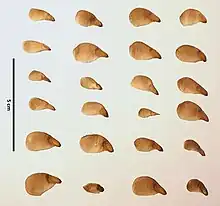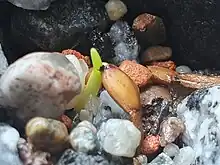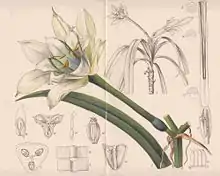Pamianthe
Pamianthe is a genus of South American bulbous perennials in the Amaryllis family, subfamily Amaryllidoideae.[4] They can be found in sandy, but rocky areas in Colombia,[5] Ecuador, Peru, and Bolivia.[2][6]

Papery thin seeds of Pamianthe peruviana

Germinating Pamianthe peruviana Stapf seed with emerging leaf
| Peruvian daffodil | |
|---|---|
 | |
| Pamianthe peruviana[1] | |
| Scientific classification | |
| Kingdom: | Plantae |
| Clade: | Tracheophytes |
| Clade: | Angiosperms |
| Clade: | Monocots |
| Order: | Asparagales |
| Family: | Amaryllidaceae |
| Subfamily: | Amaryllidoideae |
| Genus: | Pamianthe Stapf[2][3] |
| Type species | |
| Pamianthe peruviana | |
Description
Generative characteristics
The plants produce umbels of large, fragrant white flowers in the spring. They resemble daffodils, hence the common name Peruvian daffodil for at least one of the species. Pamianthe pollen grains are large and the surface structure is coarsely reticulate.[7] The winged, flattened seeds of Pamianthe have a brownish-black seed coat.[8]
Species
As of July 2019, Plants of the World Online accepts three species:[2]
- Pamianthe ecollis Silverst., Meerow & Sánchez-Taborda – Colombia (Cauca)[5][9]
- Pamianthe parviflora Meerow – Ecuador (Zamora-Chinchipe)
- Pamianthe peruviana Stapf (syn. Pamianthe cardenasii) (Peruvian Daffodil) – Peru, Bolivia (Cochabamba)
- Formerly included[10]
see Leptochiton
- Pamianthe andreana - Leptochiton quitoensis
- Pamianthe quitoensis - Leptochiton quitoensis
References
- 1933 illustration from Botanical Magazine 156: plate 9315
- "Pamianthe Stapf". Plants of the World Online. Royal Botanic Gardens, Kew. Retrieved 2019-07-03.
- Stapf, Otto 1933. Gardeners' Chronicle & Agricultural Gazette ser. 3. 93: 106
- Stevens, P.F., Angiosperm Phylogeny Website: Asparagales: Amaryllidoideae
- Meerow, Alan W.; Silverstone-Sopkin, Philip A.; Zuluaga-Tróchez, Alejandro; Sánchez-Taborda, Jhon A. (2019-01-17). "A remarkable new species of Pamianthe (Amaryllidaceae) from the Department of Cauca, Colombia". PhytoKeys. Pensoft Publishers (115): 73–82. doi:10.3897/phytokeys.115.30755. ISSN 1314-2003. PMC 6345734. PMID 30692867.
- Jørgensen, P. M., M. H. Nee & S. G. Beck. (eds.) 2014. Catálogo de las plantas vasculares de Bolivia, Monographs in systematic botany from the Missouri Botanical Garden 127(1–2): i–viii, 1–1744. Missouri Botanical Garden Press, St. Louis
- Meerow, A. W., & Dehgan, B. (1988). Pollen Morphology of the Eucharideae (Amaryllidaceae). American Journal of Botany, 75(12), 1857–1870. https://doi.org/10.2307/2444740
- Meerow, A. W., & Dehgan, B. (1985). The Auriculate Pollen Grain of Hymenocallis quitoensis Herb. (Amaryllidaceae) and its Systematic Implications. American Journal of Botany, 72(4), 540–547. https://doi.org/10.2307/2443586
- Meerow, Alan W.; Gardner, Elliot M.; Nakamura, Kyoko (2020-11-05). "Phylogenomics of the Andean Tetraploid Clade of the American Amaryllidaceae (Subfamily Amaryllidoideae): Unlocking a Polyploid Generic Radiation Abetted by Continental Geodynamics". Frontiers in Plant Science. Frontiers Media SA. 11: 582422. doi:10.3389/fpls.2020.582422. ISSN 1664-462X. PMC 7674842. PMID 33250911.
- WCSP, World Checklist of Selected Plant Families, The Board of Trustees of the Royal Botanic Gardens, Kew, retrieved 2015-04-07, search for "Pamianthe"
This article is issued from Wikipedia. The text is licensed under Creative Commons - Attribution - Sharealike. Additional terms may apply for the media files.